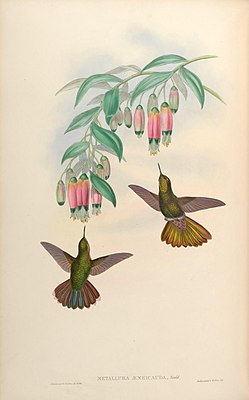Shiny belly tails
| Shiny belly tails | ||||||||||||
|---|---|---|---|---|---|---|---|---|---|---|---|---|

Shiny belly tails illustrated by John Gould and Henry Constantine Richter |
||||||||||||
| Systematics | ||||||||||||
|
||||||||||||
| Scientific name | ||||||||||||
| Metallura aeneocauda | ||||||||||||
| ( Gould , 1846) |
The shed abdominal Glanzschwänzchen ( Metallura aeneocauda ) or Schuppenglanzschwänzchen is a species from the family of humming (Trochilidae), which in Peru and Bolivia occurs. The IUCN assesses the population as Least Concern .
features
The shiny-tummy tail reaches a body length of about 12 to 13 cm, with a weight of 5.2 to 5.8 g. The male has a medium-long straight black beak. The top is bottle green. The underside looks scaly due to light brown feathers on the edge. The throat spot shimmers green. The slightly forked tail shimmers sky blue and bronze green on the top and glitters green on the underside. The female is very similar, but looks more spotted on the underside. Only the central feathers are green. The throat patch is patchy. The outer control springs have pale tips. Young animals resemble the females.
Behavior and nutrition
The shinelike tail gets its nectar from plants of the genera barberries , brachyotum , centropogon , gentians , currants and other plants with 2 to 4 cm long corollas to which it often clings. It also feeds abundantly on insects. Males establish a foraging territory . When looking for food, it buzzes about 2 meters above the ground.
Reproduction
In May to June, shiny shed tails with enlarged gonads were analyzed. A clutch consists of two white eggs that are incubated by the female.
Vocalizations
The hunting call sounds almost identical to that of Kupferglanzschwänzchens ( Metallura Theresiae Simon , 1902) and the fire-throated Glanzschwänzchens ( Metallura eupogon ( Cabanis , 1874)). The song consists of a decreasing series of three to six squeaky tones, which repeated lively disorderly phrases such as trt-tsi-sii-sii-su..trr-tsi-tsi tsu..trr-tsu .. sound, follow . The structure is similar to other members of the genus.
distribution and habitat
The shinelike tail prefers clearings in cloud and cloud forests and at the tree line . Occasionally it is on rocky slopes with herbs, low undergrowth and isolated bushes. It moves at altitudes between 2500 and 3600 meters, but it is usually over 3000 meters on the move.
migration
The shinelike shiny tail is usually considered a resident bird , even if no reliable data is available. Single animals move occasionally in higher Paramo zones and possibly down into the mountain forests.
Subspecies
There are two known subspecies:
- Metallura aeneocauda aeneocauda ( Gould , 1846) occurs in southeastern Peru and northwestern Bolivia.
- Metallura aeneocauda malagae von Berlepsch , 1897 is common in central Bolivia. The subspecies has a longer beak. The tail is bronze red on top and red on the underside.
Etymology and history of research
The first description of the shinelike shiny tail was made in 1846 by John Gould under the scientific name Trochilus (-?) Aeneocauda . He attributed the type specimen to the country of Bolivia. In 1847 Gould introduced the new genus Metallura . The word Metallura is derived from the Greek words »metallon μεταλλον « for »metal« and »oura ουρά « for »tail«. The specific epithet aeneocauda is a Latin word formation from "aeneus, aes, aeris" for "of bronze color, bronze color" and "cauda" for "tail". Malagae refers to the valley of the Río Málaga , which is located in the headwaters of the Río Chapare in eastern Bolivia.
literature
- Martin Heindl, Peter Boesman in: Josep del Hoyo , Andrew Elliott, Jordi Sargatal , David Andrew Christie , Eduardo de Juana: Scaled Metaltail (Metallura aeneocauda) In: Handbook of the Birds of the World Alive . Lynx Edicions, Barcelona.
- James A. Jobling: Helm Dictionary of Scientific Bird Names . Christopher Helm, London 2010, ISBN 978-1-4081-2501-4 .
- John Gould: On twenty new species of Trochilidae or Humming-birds . In: Proceedings of the Zoological Society of London . tape 14 , no. 164 , 1846, pp. 85-90 ( biodiversitylibrary.org ).
- John Gould: Drafts for a new arrangement of the Trochilidae, with the characters of two new Genera and descriptions of three new species . In: Proceedings of the Zoological Society of London . tape 15 , no. 171 , 1847, pp. 94-196 ( biodiversitylibrary.org ).
- Hans Hermann Carl Ludwig von Berlepsch: Count Berlepsch continues that the knowledge of the hummingbird species can by no means be regarded as complete. In: Journal for Ornithology (= 5 ). tape 4 , no. 146 , 1897, pp. 89-91 ( biodiversitylibrary.org ).
Web links
- Metallura aeneocauda inthe IUCN Red List of Threatened Species 2019.1. Listed by: BirdLife International, 2016. Retrieved June 16, 2019.
- BirdLife International: Species Factsheet - Scaled Metaltail ( Metallura aeneocauda ) . Retrieved June 16, 2019.
- Videos, photos and sound recordings for Scaled Metaltail (Metallura aeneocauda) in the Internet Bird Collection
- Shiny belly tails ( Metallura aeneocauda ) at Avibase; accessed on June 16, 2019.
- Metallura aeneocauda in the Integrated Taxonomic Information System (ITIS). Retrieved June 16, 2019.
- xeno-canto: Sound recordings - Shiny belly tails ( Metallura aeneocauda )
- Scaled Metaltail (Metallura aeneocauda) in the Encyclopedia of Life . Retrieved June 16, 2019.
Individual evidence
Remarks
- ↑ Gould ordered the genus Trochilus cupreocauda a synonym for black metaltail ( Metallura phoebe ( Lesson & Delattre , 1839)), Trochilus aeneocauda a synonym for the shed abdominal Glanzschwänzchen ( Metallura aeneocauda ( Gould , 1846)), Trochilus alardi , actually Ornismya allardi ( Bourcier , 1839) synonymous with Emerald Kehl-Glanzschwänzchen , Trochilus smaragdinicollis synonymous Metallura tyrianthina smaragdinicollis ( d'Orbigny & Lafresnaye , 1838), Trochilus williami a synonym for the Green Glanzschwänzchen ( Metallura williami ( Delattre & Bourcier , 1846) ) to.
